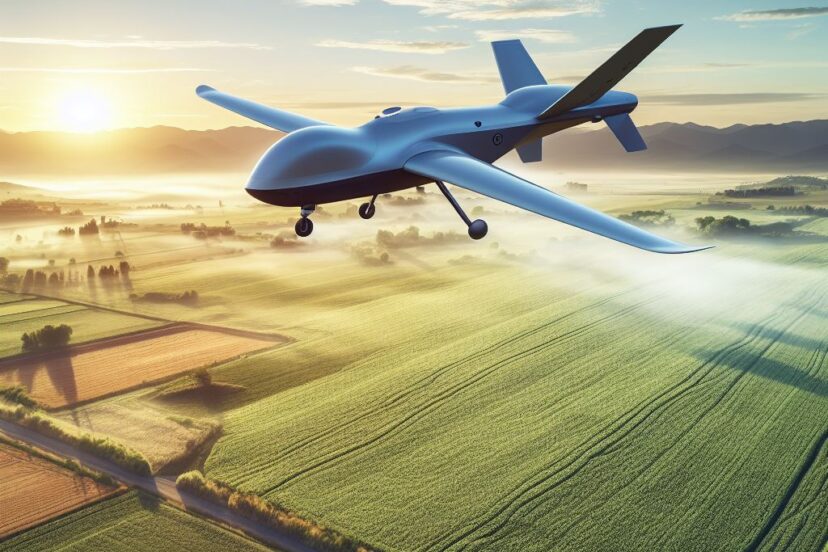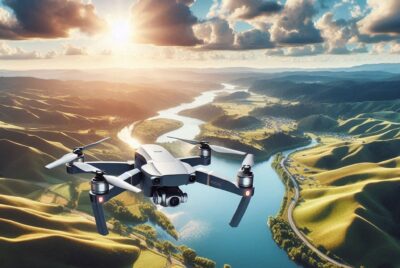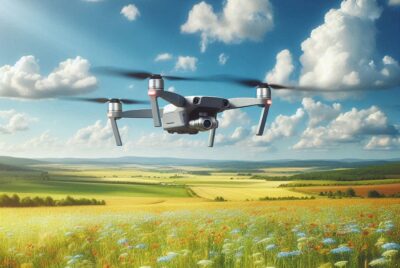Fixed Wing Drones: Revolutionizing Aerial Surveillance
*We may earn a commission for purchases made using our links. Please see our disclosure to learn more.
Fixed Wing Drones: Unmatched Efficiency in Aerial Surveying and Mapping
Drones have become an integral part of various industries, ranging from photography and surveying to agriculture and defense. Among these, fixed-wing drones represent a specialized category, designed for longer flights and higher speeds compared to their multirotor counterparts. These drones emulate the traditional airplane design, with wings providing lift, thus conserving energy and enabling them to cover vast distances efficiently.
Selecting a fixed-wing drone requires attention to several key factors. Its wingspan and overall size dictate the space needed for takeoff and landing, which is crucial for operating in constrained locations. Payload capacity is another crucial aspect, as it determines the types and weights of equipment the drone can carry, affecting applications like aerial mapping or search and rescue. The material construction impacts durability and flight performance, essential for the potential rough handling and varying weather conditions these drones often face.
Given their complexities, it’s important to look into the specifics, like battery life and engine type, whether electric or gas-powered, as they directly relate to range and endurance. Beyond the technical specifications, the ease of use, from launch and recovery systems to the interface of the control software, plays a vital role, especially for those new to operating drones in professional settings. After conducting thorough research and testing several models, I’ve identified options that stand out for their reliability, performance, and user-friendliness. This guide will help you navigate through the nuances of fixed-wing drones to find one that best suits your mission requirements.
Top Fixed Wing Drones
I’ve examined the market to help you find the best fixed wing drones available today. Fixed wing drones offer longer flight times and more stable flight dynamics compared to their rotary counterparts, making them ideal for aerial surveying, mapping, and long-range operations. My carefully curated selection reflects leading technologies and the most reliable manufacturers in the field, ensuring you get the quality and performance you seek in a fixed-wing UAV.
SoloGood T-01
I’d recommend this for anyone who wants to experience flying without the complexity, thanks to its durability and beginner-friendly design.
Pros
- Durably built with materials like EPP foam and carbon fiber
- Features dual motors with strong power output
- Easy to transport and assemble, perfect for on-the-go flying
Cons
- Does not include battery, charger, or transmitter
- Limited to no instructions for assembly, which may be challenging for novices
- Several reports of components failing prematurely
I just had the chance to fly the SoloGood T-01, and it was indeed a delight. Constructed from resilient materials like EPP foam, this plane handled minor crashes without significant damage. The wings detach safely upon impact, which adds to its longevity.
The aircraft boasts a sleek design with an excellent thrust-to-weight ratio thanks to the dual motors. It soared smoothly through the air, and the slow flying capability made it a dream to pilot in tighter spaces. The range of load adjustment also impressed me, catering to different flying conditions.
Setting up the T-01 was a breeze. It’s designed for quick assembly, so I spent less time on the ground and more in the air. Perfect if you’re heading out for a quick flight session. It’s quite compact and light, fitting snugly in the car without requiring a lot of space.
Buddy RC Dark Breeze
After many flights, I can confidently say the Buddy RC Dark Breeze makes for an excellent FPV glider, particularly if you’re after ease of use and durability.
Pros
- High resilience against impact due to EPP foam material construction.
- Stealthy looks and lightweight design ensure nimble in-air operation.
- No need for FPV registration, offering hassle-free flying experiences.
Cons
- Limited in its payload capacity given the lightweight design.
- Beginners might find the FPV setup requiring a bit of a learning curve.
- Without proper care, the lightweight foam can be susceptible to damage especially in harsh conditions.
In my time flying the Buddy RC Dark Breeze, I immediately noticed its high-quality EPP foam makeup. This material truly does wonders in absorbing impacts from those inevitable crash landings. I’ve put it to the test more than once, and each time it bounced back ready for another go.
Its design strikes a fine balance between being lightweight for agile flying and sturdy enough to withstand general use. I’ve taken it out on many afternoons and it has proven to be a reliable companion each time. That said, I’ve learned to be careful in heavier winds as the lightweight frame can be a bit trickier to manage in these conditions.
Lastly, the Dark Breeze omits the hassle of FPV registration, which I’ve found to be a significant convenience. Not having to deal with bureaucracy before flight is a breath of fresh air. The compatibility with various cameras is a bonus, allowing for a customized FPV experience. All in all, my experiences with the Buddy RC Dark Breeze FPV Plane have been largely positive, aside from the few minor considerations to be mindful of.
SoloGood Delta Wing R690
I recommend the SoloGood Delta Wing R690 to experienced beginners who value a blend of durability and customization in their fixed-wing drones.
Pros
- Durable EPP/ABS/Carbon Fibre construction
- Adjustable rudder volume size for enhanced control
- Lightweight design optimized for DJI digital transmission systems
Cons
- Not beginner-friendly; requires prior knowledge and skill
- No electronics included, additional purchases necessary
- Some reports of damage during shipping
Feather-light in my hands, the SoloGood Delta Wing R690 crafted from EPP/ABS with a carbon fibre skeleton speaks volumes of its robustness. After several outings, its sturdiness isn’t merely theoretical; it’s survived the occasional mishap unscathed. The magnetic cabin cover snaps confidently in place, a small but reassuring detail for any flying enthusiast.
In-flight, the adjustable rudder volume proves invaluable for refining control, allowing for smooth adjustments and a personalized touch. The tailored bases for DJI systems demonstrate SoloGood’s commitment to modern standards, accommodating my high-definition digital transmission needs without hitch or hurdle.
However, the absence of electronics in the kit means I had to invest extra time and money to get airborne. While the assembly process is a joy for those familiar with RC aircraft, beginners might find the initial setup daunting. Moreover, despite the craft’s solid design, reports of damage upon arrival can’t be ignored, suggesting potential packaging or transportation issues to be aware of.
Buddy RC Talon GT
If you’re stepping into FPV flying, the Buddy RC Talon GT’s robust construction and ease of control make it a solid choice for beginners and enthusiasts alike.
Pros
- Exceptionally durable BEPP foam
- Integrated carbon fiber for enhanced performance
- Compatible with a wide range of FPV cameras
Cons
- Assembly required; not ready-to-fly
- No electronics included in kit version
- Limited customer reviews for thorough vetting
Flying the Buddy RC Talon GT immediately gives a sense of its sturdy build. The high-quality BEPP foam has already withstood several less-than-perfect landings without as much as a dent. The manufacturer wasn’t kidding about the impact resistance, and it’s reassuring to know that the aircraft can handle a few bumps.
The in-built carbon fiber components are a testament to the thoughtful design. I can feel the rigidity and stability during flight, which translates to more controlled maneuvers and a better overall flying experience. For those looking to customize their aircraft, the fuselage offers ample space for modifications, and the FPV camera compatibility is a significant plus.
Unfortunately, it’s not a grab-and-fly kind of deal. The assembly took a bit of time, and sourcing the electronics separately means that beginners might have a slightly steeper learning curve. However, once set up, the Buddy RC Talon GT performs admirably. I can certainly appreciate the craftsmanship that went into this aircraft, even if it meant some initial elbow grease on my part.
Buying Guide
When I approach the purchase of a fixed-wing drone, I start by considering my specific needs, which dictate the features I should look for.
Purpose and Performance
I assess the purpose of the drone. Whether it’s for surveying, mapping, or leisure, each application has its own set of performance requirements.
- Endurance: How long can the drone fly on a single charge?
- Range: What distance can the drone cover?
- Payload Capacity: How much weight can the drone carry?
Material and Design
The material and design impact the drone’s durability and flight efficiency. I check the following:
- Material: Is it made of lightweight composites for better flight time?
- Design: Does the aerodynamic design contribute to stable flight?
Technology and Features
I examine the technological features that enhance the functionality of the drone.
- Navigation System: Is it equipped with advanced GPS for precise positioning?
- Camera Quality: For imaging purposes, a high-resolution camera is essential.
- Autopilot Features: Does it have programmable waypoints for automated flights?
Cost and Support
Finally, I consider the cost relative to the features offered and look for good customer support.
| Factor | Considerations |
| Price | Does it offer value for money? |
| Warranty | Is there a comprehensive warranty? |
| Customer Support | Assistance available post-purchase? |
By evaluating these factors carefully, I make an informed decision that matches my requirements without getting swayed by extraneous features.
Frequently Asked Questions
In this section, I address some common inquiries regarding fixed-wing drones, providing you with concise and relevant information.
1. What are the advantages of using fixed-wing drones in agriculture?
Fixed-wing drones excel in agriculture due to their efficiency in covering large tracts of land and their prolonged flight times, which maximize aerial data collection for crop monitoring and land management.
2. How does a hybrid VTOL drone differ from conventional fixed-wing drones?
Hybrid VTOL (Vertical Takeoff and Landing) drones incorporate the benefits of both fixed-wing and rotorcraft designs, enabling vertical takeoffs and landings while retaining the extended range and speed of fixed-wing drones.
3. What factors contribute to the cost of fixed-wing drones?
The cost of fixed-wing drones is influenced by factors such as materials, design complexity, onboard technology like autopilot systems, and camera specifications, as well as the intended use-case scenarios that dictate their features and capabilities.
4. Which fixed-wing drone models are known for having the best camera integration?
Models such as the SenseFly eBee X and the PrecisionHawk Lancaster 5 are highly regarded for their advanced camera integration, offering high-resolution imaging and versatility for various aerial surveying applications.
5. What should be considered when looking for long-range fixed-wing drones?
When searching for long-range fixed-wing drones, one must consider battery life or fuel capacity, communication systems for beyond visual line of sight (BVLOS) operations, and the drone’s payload capacity, which can influence its range and performance.








